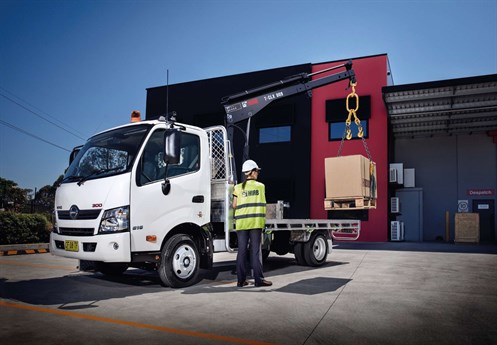- ETRUX launches new Ford E-Transit Trizone
- Renault gives UK debut to Master E-Tech at CV Show
- Isuzu D-Max long-term test – Latest Report
- Isuzu D-Max V-Cross Steel Edition revealed
- IVOTY Report: Stellantis explores the hydrogen proposition
- New Maxus EVs include eDeliver 5 van
- Used LCV values reach six-month high
- ADVERTISEMENT FEATURE: IVECO Daily Mission Awards 2024 Q2 Round-up: Grounds Maintenance & Forestry
- Stellantis Pro One electric vans review
- Mitie adds 5,000th EV to fleet
TAIL-LIFTS & CRANES: Getting into the swing
Date: Monday, October 7, 2019 | Author: Steve Banner

Hiab’s T-009 in action
(Continued from previous page) Tipper bodybuilder Tipmaster markets the Swift Lift, which can raise up to 300kg alongside its Tommy Lift range of tail-lifts with capacities of up to 500kg.
Speed of delivery, the greater ability for drivers to make deliveries unaccompanied and the reduced risk of injuries caused by heaving about heavy objects are all good reasons for equipping a van with a tail-lift, depending on the type of delivery involved.
It too should be accompanied by battery protection. As is the case with a crane, a tail-lift’s weight will reduce the vehicle’s payload capability.
Crane and tail-lift manufacturers are continually attempting to cut the weight of their products without compromising their lifting capacity or durability, with some of Penny’s tail-lifts weighing no more than 60kg. They are doing so through more intelligent design and the use of plastics, aluminium and high-strength steel where possible and practical.
Hiab, for example, reckons it has reduced the weight of its latest DEL DL500 column tail-lift by 10% without reducing its ability to lift 500kg loads. It also makes the point that the newcomer is equipped with a quieter chain roller; the quieter a tail-lift is, the more likely it is to be acceptable for making deliveries at night.
Launched at this year’s CV Show, the DL500 can be specified with safety guards that deploy automatically when the lift is used, to stop an operator standing on the platform tumbling off.
Adding options increases tail-lift weight, but weight savings can be achieved on box and Luton bodies by deleting the rear barn or roller shutter doors and using a lift platform as the rear closure instead. It can be supplemented by a flap to bridge any gap between the platform’s edge and the body’s roof when the platform is stowed.
Aluminium platforms make sense if weight-saving is a key consideration, and have the added advantage that they do not corrode. They may not be the right choice if the vehicle is being used to collect cargo such as industrial waste, however, says hydraulic equipment supplier Dhollandia. A robust steel platform may be a better choice, it suggests. As a consequence it offers a dump-over version of its DH-VO.07.K1 500-750kg-capacity column lift, which can be fitted to a tipper and has a foldable steel platform. Fold it, and it does not get in the way when the tipper’s body is raised and its contents are discharged. Other lift manufacturers – Tommy Lift, for example – have dump-thru or dump-over models for tippers in their line-ups too.
PUWER applies to tail-lifts in the same way that it does to cranes. Furthermore, LOLER (the Lifting Operations and Lifting Equipment Regulations 1998) requires cranes and tail-lifts to undergo periodic thorough examinations by ‘a competent person’ – an appropriately qualified engineer, for example – to ensure that they remain fit for use.
Prices for cranes and tail-lifts vary depending on how much lifting capacity you require. Penny’s PH cranes start at around £3,000, while one of its tail-lifts capable of raising 500kg will set you back roughly £2,500 to £3,000.
While tail-lifts can reduce the risk of musculoskeletal injury, paradoxically they can also raise operational safety concerns. Some businesses delivering palletised loads using vehicles with a driver on his or her own, a tail-lift and a manually operated pallet truck have limited the weight of the full pallets they will handle to 750kg. Anything heavier is too much for an individual employee to handle without assistance or better equipment – a power-operated pallet truck and an extra-large lift platform, for instance – they contend.
Their concerns have arisen in the wake of the death of a delivery driver in 2016 while unloading a pallet of goods weighing upwards of a tonne.
Admittedly the majority of tail-lifts fitted to light commercials have a capacity no greater than 500kg. Deduct the weight of the driver and the pallet truck, however, and that still means you could be dealing with pallets weighing over 350kg – and whoever is loading or unloading them needs to be trained accordingly.
Not sure how much that pallet of goods weighs? Suspect that it may be heavier than the label says it is? Then it is worth noting that Avery Weigh-Tronix has launched the PTS2000S pallet truck scale, which enables a pallet to be weighed while it is being moved. The scale has Legal for Trade status says the firm.
This means that if you are delivering goods for a third-party and charging them by weight, you can legitimately surcharge them if the weight has been under-declared. Wireless and Bluetooth connectivity allow for the instant transfer of weight data from the scale to the user’s back-office – avoiding the errors often associated with manual data input.
View The WhatVan Digital Edition


